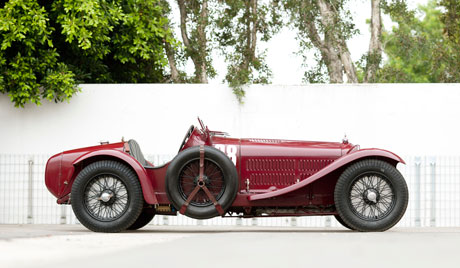I know a number of extremely knowledgeable individuals who simply state that if they could own only one collector car, it would be an 8C 2300
In the early 1930s, Italian road racing, and motor sport in general, relied on various tiers of competitors to fill the grids: factory entries, successful privateers, loosely organized regional teams, and bold individuals. It was perhaps the most romantic era of motor racing, and was characterized by tremendous variety, national pride, heroism, triumph and tragedy. Generally speaking, the strict amateurs ran Fiat Balillas; gentleman drivers had small-displacement Alfa Romeos and Maseratis; and the most serious competitors, both in talent and funds, largely relied on Alfa Romeo’s Monza. Comprised of a purpose-built frame, rigid suspension, a highly-tuned supercharged twin-cam, 2.3-liter, 8-cylinder engine and bodywork that could be transformed from a road-going sports car to an open-wheeled Grand Prix machine, the Monza was the ultimate sporting variation of Alfa Romeo’s most celebrated chassis. Presented here is a genuine factory Monza—a car that spent its earliest years in the company of successful Genovese drivers, each a regular at many of the important national events.
The proud owner has described the 8C as having tremendous personality. It is no wonder words like “thoroughbred” are used to describe the Monza, as a well-sorted example behaves like a living, breathing beast, one that responds to a light rein. This Monza is extraordinarily tight and responsive and reacts like an extension of one’s own thoughts. Its instantaneous throttle response, smooth linear power curve, and precise gearbox combine to give this car a tremendous degree of balance, composure, and feedback, and a remarkable ability to be drifted through fast corners with ease and great control of the throttle. The sound alone is worth the price of entry. A mechanical symphony produced by the spinning of gears, supercharger vanes and the whirl of the valve train amplify into the kind of great booming that can only come with a race-tuned, twin-cam straight eight. No matter how many times you hear the soundtrack of the Monza, it never fails to impress. There is always a new element to be discovered in its complexity and beauty.
The factory-built 8C Monzas are among the top tier of collector cars, and this is a star among the best of them. When leading 8C authority Simon Moore states, “This is a lovely, original Monza,” how can you argue with its pedigree?
1933 Alfa Romeo 8C 2300 Monza

